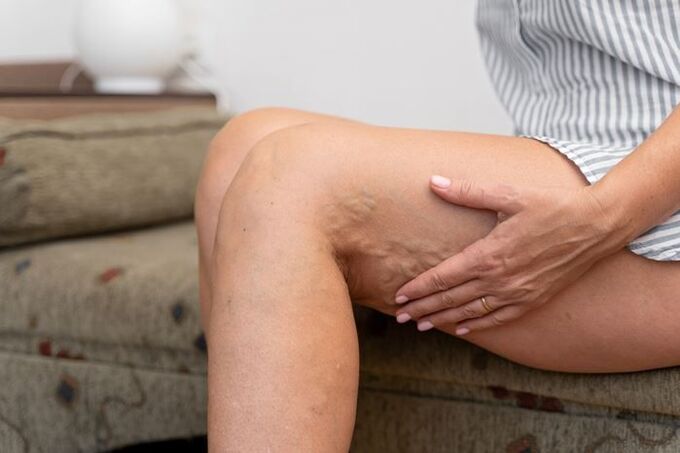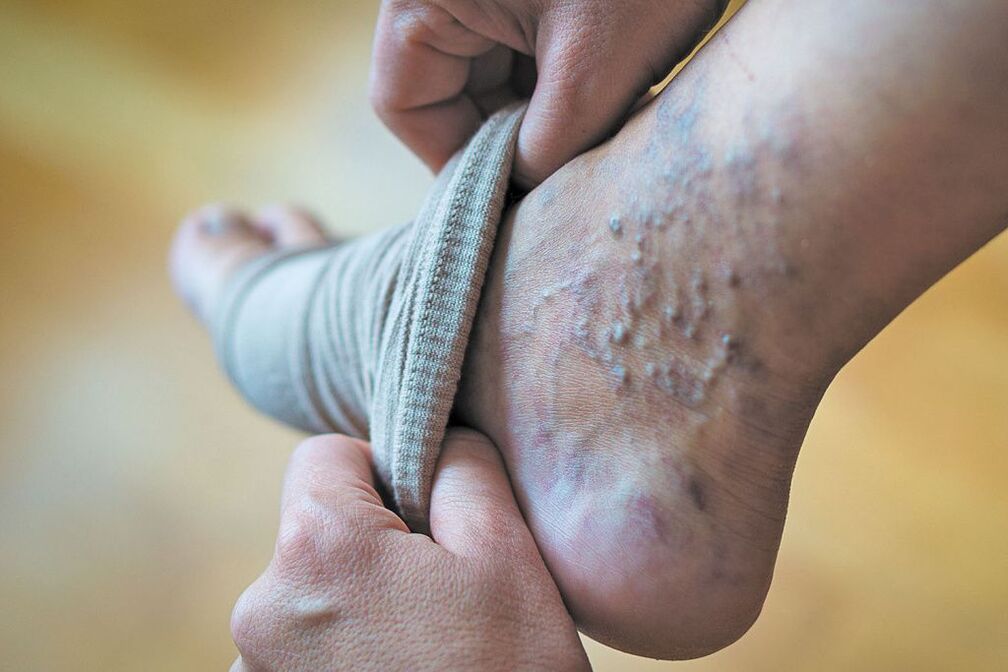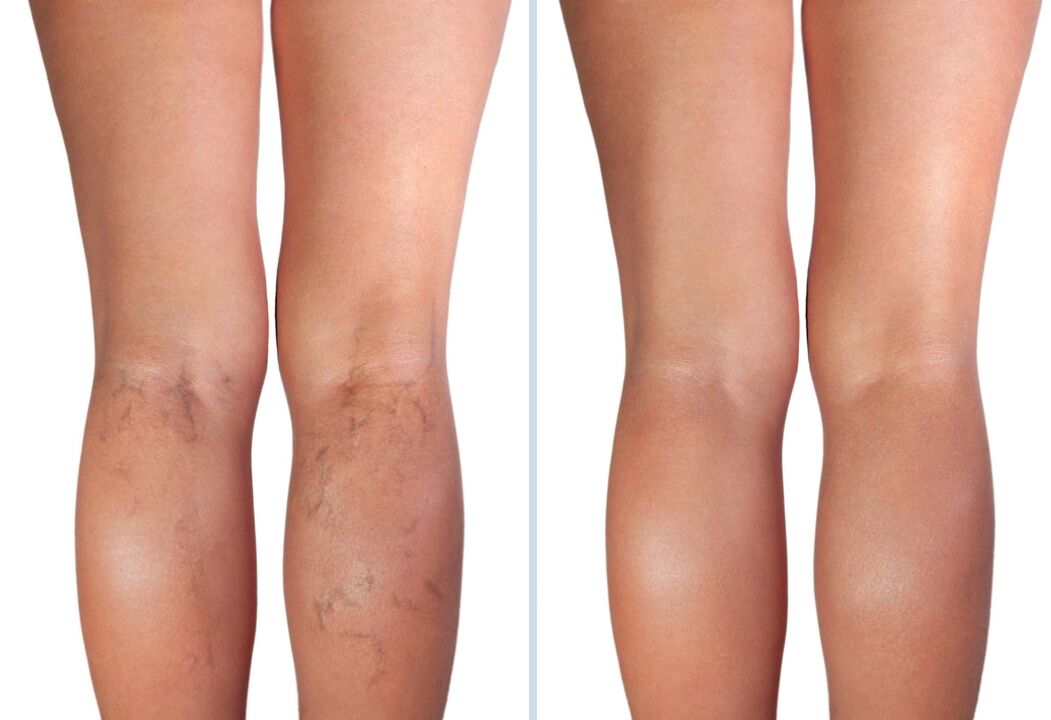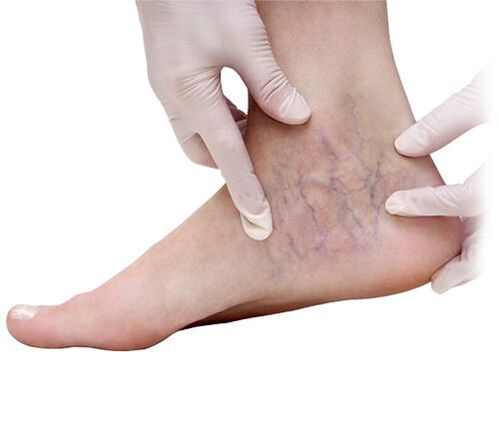
Varicose veins, varicose veins, varicose veins
- uneven increase in the lumen and length of the veins,
- formation of nodules in the area of thinning veins due to pathological changes in the venous walls, thinning, stretching, reduced tone and elasticity,
- functional insufficiency of venous valves and impaired blood flow.
Varicose veins are a fairly common disease. Varicose veins and their complications are diagnosed in 25% of the population, women suffer 2-3 times more often than men. In women, the first signs of the disease are often observed at a young age, most often during pregnancy and childbirth. In old age, the incidence increases among both men and women, and the frequency of complicated forms increases. At the age of 70, the disease occurs 6-10 times more often than at the age of 30. However, recently, the manifestation of varicose veins is often observed in very young people, even teenagers. Therefore, it becomes an increasingly urgent task to reveal all possible causes of the disease and to prevent venous disorders.
How varicose veins develop and develop
To understand the development of varicose veins, let's briefly explain the physiology of the venous system of the lower extremities. Venous outflow of the legs is provided by two interconnected mechanisms - central and peripheral. The central mechanism is related to the heart, lungs, and diaphragm, and the peripheral mechanism is directly related to the functioning of the venous system of the lower extremities with the system surrounding the vessels of muscles and tissues.
The initial signs of varicose veins are capillary circulation disorder, swelling, heaviness in the legs, the appearance of spider veins and spider veins. These changes are reversible, but if timely preventive measures are not taken, the problems will increase.
Usually, more than a year passes from the initial signs of varicose veins of the lower limbs to the formation of varicose nodes and the appearance of pronounced symptoms of varicose veins. Varicose veins that develop gradually lead to poor blood flow and chronic venous insufficiency. Stagnation of blood in the veins can lead to phlebitis (inflammation of the veins), thrombophlebitis (inflammation of the veins with the formation of blood clots), phlebothrombosis (thrombosis with further inflammation of the veins), non-healing dermatitis (inflammation of the veins). skin), trophic ulcers.
Types and forms of varicose veins

There are primary (true) and secondary (with symptoms) varicose veins.
Primary varicose veins are an independent disease of the venous system (varicose veins). It develops gradually over several years. Varicose dilatation of the great saphenous vein is observed most often (70-85%), less often - the small saphenous vein (5-12%). In the case of varicose veins, 50-70% of vein damage is bilateral.
Secondary varicose veins are a symptom and consequence of diseases in which there are obstacles in the outflow of blood through the deep veins of the lower limbs (diseases after thrombosis, tumors, scars, inflammatory processes, aplasia and dysplasia of the deep veins, arteriovenous fistulas, etc. ). Secondary varicose veins are quite rare.
Varicose veins most often affect the saphenous veins of the lower extremities, which are part of the great saphenous vein system. Branches of the small saphenous vein suffer from varicose veins much less often.
Classification of types of varicose veins
Until recently, doctors in Hungary classified varicose veins according to several classifications. The staged clinical classification of V. S. Saveljev was used, which reflects the degree of disturbance in the venous circulation of the limb and the ability of the body to resist and compensate for these disturbances, as well as classification according to the forms of varicose veins and the complications they cause.
However, currently the main one is the CEAP international classification, which is based on the clinical (C - clinic), etiological (E - etiology), anatomical (A - anatomy) and pathogenetic (P - pathogenesis) characteristics of the disease.
6 clinical classes ("C") are arranged with increasing severity of the disease from telangiectasias (TAE) to trophic ulcers.
The etiologic stage ("E") indicates whether the process is primary or not.
The anatomical part of the classification ("A") divides the venous system of the lower extremities into 18 relatively separate segments, which makes it possible to indicate the localization of the affected area of the venous system.
The pathophysiological stage ("P") characterizes the presence of reflux and/or obstruction in the affected venous segment.
Symptoms of varicose veins

The symptoms of varicose veins depend on the stage of the disease, e. g. about the degree of changes in the blood vessels and the disturbance of the venous system. Depending on the stage, a prognosis can be given regarding the further development of the disease.
The initial stage of varicose veins - stage 1 varicose veins
In the initial stage, when the pathology of the veins is not yet clearly expressed, visible signs of varicose veins may be absent. Patients complain of heavy and unpleasant sensations in the legs, too fast fatigue, a feeling of warmth, paresthesia (numbness, burning sensation, tingling). The symptoms worsen towards the end of the day, as well as due to heat - in summer or when warm shoes are worn indoors in winter. Swelling occurs in the foot and ankle, which disappears after a short rest. Occasionally, nocturnal cramps may occur in the calf muscles, but patients attribute them to overuse.
After prolonged physical activity, the veins swell and their network is clearly visible through the skin. They are especially noticeable on the thighs, lower legs and feet. The number of such veins and the extent of their expansion may vary. These can be unique and not very noticeable formations on the leg, which appear more clearly in the evening or after physical activity. The appearance of spider veins can also be observed in this stage of varicose veins.
If you start the simplest conservative treatment at this stage and follow preventive measures, the development of the disease can be prevented by eliminating almost all symptoms.
Symptoms of 2nd degree varicose veins, compensation stage
At this stage of the disease, changes in the large subcutaneous vessels become noticeable. The veins are deformed and swollen, the outflow of blood is interrupted, and noticeable swelling occurs in the feet and ankles. Swelling on the legs increases as a result of prolonged physical activity, but disappears after a night's rest. Calf muscle cramps are common at night. Paresthesia is observed - temporary loss of sensation in the legs, numbness of the legs, burning, "goosebumps". As the disease progresses, pain appears, which intensifies in the evening.
This stage of subcompensation usually lasts for several years, and during this time the development of the disease can be stopped if treatment is started in time. Otherwise, the disease will inevitably progress to a more serious stage.
Symptoms of varicose veins of the 3rd degree - the stage of decompensation
At this stage of varicose veins, the symptoms increase significantly, the pains are stronger, the legs become heavier, and the peripheral blood and lymph circulation is disturbed (chronic venous insufficiency). The swelling does not go away even after a long rest and spreads to the leg. Patients are bothered by itchy skin. The skin on the legs dries out, loses its elasticity, the skin is easily damaged, loses its ability to regenerate quickly, as a result of which the healing of wounds takes a long time. Brown spots appear on the skin, most often on the inner surface of the lower third of the leg (hyperpigmentation due to subcutaneous bleeding).
All these complaints are constant. In the future, heartaches, shortness of breath, headaches, and deterioration of the locomotor function of the affected limb may occur.
Although the stage of decompensation is already a very significant manifestation of the disease, with proper treatment, the patient's condition can be maintained at a satisfactory level for a long time, preserving the ability to work and preventing the transition to the stage of complications.
Varicose veins of the 4th degree - stage of complications
This stage of the disease is characterized by pronounced disorders of venous circulation. Swelling of the legs becomes almost permanent, skin itching intensifies, and trophic disorders appear on the skin of the legs. Advanced varicose veins are often accompanied by eczema, dermatitis, and long-term injuries, and since the regenerative capacity of the varicose skin is noticeably reduced, even a small wound can develop into a permanent trophic ulcer. Thinned skin and vein walls are easily damaged, causing extensive bleeding. Damaged soft tissues and open ulcers become gateways for infection.
The most common complications of varicose veins are:
- phlebitis - inflammation of the veins;
- thrombosis - the formation of a blood clot (thrombus) in the vein, which can lead to blockage of the vessel;
- trophic ulcers - they form in the place where the affected vein cannot ensure the proper outflow of blood from the skin, as a result of which the nutrition (trophism) of the tissues is damaged.
Varicose veins can be complicated by acute (sometimes purulent) thrombophlebitis
It is no longer possible to restore the state of the venous system at this stage, we can only talk about preventing further complications and improving the patient's quality of life as much as possible.
Causes of varicose veins
There is no single cause of primary varicose veins of the lower extremities. The development of this disease is usually provoked by several factors. However, the painful symptom of varicose veins is related to the structural changes in the tissue of the venous wall of the blood vessels and the disruption of the functioning of the venous valves.
What causes these violations?
We often come across the statement that one of the most important physiological reasons for the development of a disease such as varicose veins is an upright posture. In fact, in humans, by nature, the load on the vascular system of the lower extremities is very high. The outflow of blood from the veins and its ascent towards the heart is hindered by the pressure caused by gravity and the high pressure in the abdominal cavity. However, not everyone develops varicose veins. What factors provoke the development of varicose veins?
It has been established that the main risk factors for the development of varicose veins are:
- genetic predisposition (inheritance) - congenital weakness of the venous wall, disruption of the venous valves;
- female gender - women suffer from varicose veins 4-6 times more often than men;
- hormonal disorders;
- hormonal contraception;
- pregnancy, especially multiple pregnancy;
- heavy physical activity (heavy physical work, vigorous sports);
- conditions and diseases leading to increased intra-abdominal pressure (chronic respiratory diseases, constipation, etc. )
- diseases that negatively affect blood vessels (high blood sugar, diabetes, high blood pressure, etc. );
- work characteristics - standing or sitting work, sudden temperature changes, prolonged contact with high or low temperatures;
- overweight, obesity, which causes increased stress on the legs and increased pressure in the pelvic area;
- lack of vitamin C and other useful substances necessary for the vascular system;
- sedentary lifestyle, bad habits that destroy blood vessels and cause additional tension in them.
Diagnosis of varicose veins

Diagnosing varicose veins is often not difficult. A clinical examination, which includes physical examination (examination and palpation), patient assessment, collection of complaints and anamnesis (information about the course of the disease, life and work characteristics, past and present diseases) is usually used to detect serious varicose veins. the diagnosis can also be established without an instrumental examination. Exceptions are situations where varicose changes are difficult to notice due to excessive development of the subcutaneous fat tissue of the lower limbs.
Currently, duplex ultrasound scanning (USDS) is widely used to study the veins of the lower extremities. This method makes it possible to determine the localization of changes in the veins and the disturbance of venous blood flow. However, it should be known that the results of ultrasound scanning are highly subjective and depend to a large extent not only on the experience and knowledge of the researcher, but also on the tactical approach to the treatment of venous diseases used in the given medical institution. When determining treatment tactics, they are primarily guided by clinical trial data.
Duplex scanning is performed when planning the invasive treatment of varicose veins of the lower extremities. In addition, X-ray contrast venography, MRI venography, and CT venography may be used.
All these methods make it possible to clarify the localization, nature and extent of venous changes, to clearly see disorders of venous hemodynamics, to evaluate the effectiveness of prescribed therapy, and to predict the course of the disease.
Treatment of varicose veins - modern techniques
The main tasks of the doctor in the treatment of varicose veins are as follows:
- eliminating or reducing the severity of symptoms causing particular discomfort in patients - pain, swelling, cramps;
- restoring and improving the functioning of blood vessels - from capillaries to deep veins, improving the functioning of valves, restoring damaged vessel walls, increasing their elasticity and strength;
- improving the rheological properties of blood, reducing its viscosity;
- improving the functioning of the lymphatic system.
- prevention of further development of the disease and complications;
- improving the patient's quality of life.
Depending on the stage of the disease and the degree of vessel damage, the doctor can prescribe the most optimal treatment methods for the given situation, such as
- conservative treatment– recommendations for prevention and lifestyle changes, drug therapy, compression therapy;
- non-surgical invasive procedures- sclerotherapy, echosclerotherapy, foam sclerotherapy (Foam-form therapy), etc. ;
- surgery- phlebectomy, thermal obliteration, stripping, combined methods and operations of increased complexity for complications of varicose veins and treatment of trophic ulcers of the lower limbs.
These methods make it possible to improve the blood circulation of the lower limbs, including microcirculation, eliminate many cosmetic defects caused by varicose veins, and relieve the patient from a significant part of the painful manifestations of the pathology.
Conservative methods of treating varicose veins
Modern conservative therapy of varicose veins provides an integrated approach to treatment and includes several areas:
- lifestyle changes;
- pharmacological therapy;
- compression therapy.
It is no coincidence that lifestyle change is in the first place. The removal of sludge is necessary, if possible, at least in order to reduce the impact of unfavorable factors.
One is sustained static load while standing or sitting, which leads to blood stasis. To activate the musculo-venous pump of the lower leg, you need to regularly stretch your legs and walk more. During work, you can periodically perform exercises with alternating contraction and relaxation of the lower leg muscles (raised on toes).
It is recommended to make time for outdoor sports that do not involve the risk of foot injury (sports or Nordic walking, exercise bikes, treadmills, swimming, cycling and walking).
If you have varicose veins, do not overheat your legs, avoid baths and saunas.
Patients with varicose veins should monitor their weight. It is known that with a body mass index above 27 kg/m2the probability of developing varicose veins increases by 30%. Being overweight is often associated with elevated sugar levels, which leads to problems with the healing of venous ulcers and the risk of recurrence.
The effectiveness of compression therapy is explained by the possibility of reducing the reverse blood flow, a slight decrease in the pathological capacity of dilated veins, which leads to a decrease in swelling, an improvement in the blood flow of the capillaries and a reduction in the symptoms of varicose veins.
In addition to bandages and knitwear, there is hardware compression therapy, which is particularly effective for chronic venous edema and trophic ulcers.
In the early stages of varicose veins, drug treatment can be recommended as the main type of therapy, supplemented with flexible compression if necessary. Medicines are also prescribed to prepare for surgical treatment or to speed up rehabilitation and prevent complications in the postoperative period.
The following drug groups are used to treat venous diseases:
- phlebotonics and angioprotectors;
- anticoagulants and thrombolytics;
- anti-inflammatory and pain relievers;
- vascular regenerating agents.
For the systemic treatment of varicose veins, mainly bioflavonoids, rutin derivatives, saponins, etc. based venotonics and angioprotectors are used, which increase the flexibility and tone of veins, increase the strength of blood vessels, improve lymph outflow and reduce lymph pressure. . Anticoagulants are prescribed if there is a risk of thrombosis. Anti-inflammatory and painkillers are used in the case of complications of varicose veins - inflammation of veins, severe pain, trophic changes in veins.
In addition to systemic drugs, local drugs are also used - ointments and gels based on venoactive agents, heparin, non-steroidal anti-inflammatory drugs, corticosteroid ointments.
Non-surgical invasive procedures
Venous sclerotherapy is an outpatient medical procedure in which a special substance called sclerosant is injected into the capillary or problematic vein using a thin needle. The vessel is then compressed with a latex pad or elastic bandage. The walls of the vessel "stick together", the blood flow in the vessel stops. The glued walls usually grow together, scar, and the scar disappears. It is used to treat small superficial varicose veins. The method is effective in the early stages of the disease, only in cases where the varicose veins are only smallit is localized in veins and allows the elimination of cosmetic defects. Several treatments may be required to achieve results.
It distinguishes a special sclerosis. Similar to sclerotherapy, a sclerosing substance is injected into the damaged vein in the form of a fine foam, which quickly "seals" the large affected veins. The method does not require many procedures and provides excellent results. It is important to know that the procedure - although rare - can have side effects - visual impairment. It is also dangerous that the sclerosant gets into the arteries and nerve tissues. The procedure should be performed by an experienced phlebologist.
Absolute contraindications to sclerotherapy - drug allergy, deep vein thrombosis, pregnancy, breastfeeding
Surgical treatment of varicose veins
In severe, advanced cases, or even if conservative methods fail to stop the development of the disease, surgical treatment is usually recommended.
The goals of surgical intervention for varicose veins are as follows
- elimination of cosmetic defects;
- reduction of subjective symptoms (pain, burning sensation, paresthesia, heaviness in the legs, etc. );
- prevention of deterioration of the saphenous veins;
- prevention of bleeding from varicose veins;
- prevention of thrombophlebitis;
- reducing and preventing the development of venous edema;
- reduction of manifestations and prevention of hyperpigmentation, lipodermatosclerosis;
- acceleration of healing and prevention of recurrence of venous trophic ulcers.
According to clinical guidelines, the goals of surgical treatment are:
- elimination of abnormal vertical and/or horizontal reflux;
- elimination of varicose saphenous veins.
The risk of developing venous thromboembolic complications (VTEC) should be assessed before any type of surgical intervention.
Depending on the situation, several surgical methods can be used:
Venous suturing is the placement of multiple stitches in a damaged vein that prevent blood from flowing through the vein. As a result, blood clots form and the vein gradually degenerates.
It is important to remember that surgery is not a permanent cure, but rather an elimination of symptoms. After the operation, conservative treatment is also necessary, even for life, this must be explained to the patients.
Depending on the stage of varicose veins, symptoms, accompanying diseases and the general state of health of the patient, the doctor selects specific recommendations in order to achieve the fastest possible improvement.























